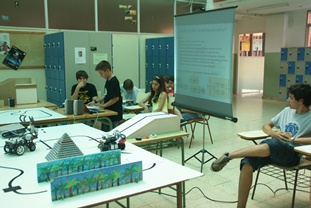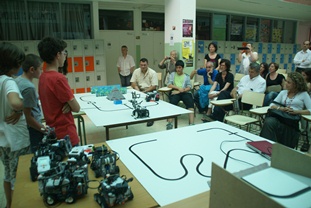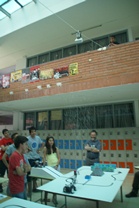Presentació del Taller de Robòtica Educativa BOGATECH a l'Institut Icària, Barcelona
18-06-12
Els alumnes del Taller de Robòtica Educativa BOGATECH (nivell d'iniciació, nivell avançat i de competició, i nivell de recerca) van fer la presentació del seu treball durant el curs. Els alumnes del nivell d'iniciació varen explicar el seu projecte de final de curs inspirat en la història de King Kong. Un explorador porta la protagonista a través de la selva seguint rastres. Quan els rastres desapareixen s'orienta amb els arbres. Un cop arriba al campament deixa a la protagonista i puja a la piràmide. Mentre tant, King Kong espia l'escena i rapta la protagonista amb el seu gran braç potent. Quan l'explorador arriba a dalt del temple crida un avió que llença confetis d'amunt tota l'escena. A nivell tècnic, l'explorador compta interseccions (i les sap diferenciar de les zones negres) per saber si ha de girar a dreta o esquerra, si ha arribat al campament per deixar la protagonista o si ha finalitzat el seu recorregut dalt de la piràmide i ha de cridar l'avió. L'avió és una mena de telefèric amb una cabina que penja d'un cable i una base d'arrossegament que l'estira. La connexió entre l'explorador, l'avió i la plataforma de llançament es realitza via bluetooth, i el robot King Kong fa de pont de connexió entre els 3 robots.
Els alumnes del nivell avançat i de competició varen exposar i comprar diferents versions d'un robot de rescat, amb tracció d'erugues, tracció 4 rodes i tracció 2 rodes. Els robots utilitzen de 2 a 3 sensors de llum o color per seguir línies, 2 sensors ultrasònics o electroòptics per seguir parets i un sensor de tacte combinat amb un sensor de color per detectar obstacles i diferenciar-los de la víctima. Els alumnes varen explicar els seus programes estructurats segons una màquina d'estat. També varen ensenyar l'estratègia que utilitza el robot en la sala 3 per detectar la víctima, agafar-la i portar-la al punt d'evacuació.
Per acabar, els alumnes del taller de recerca varen exposar el seu treball de quart de ESO que consisteix en la "aplicació d'un controlador PID a un robot de rastrejador". El controlador Proporcional Integral Derivatiu és un algoritme molt comú en enginyeria i els alumnes han estudiat la seva aplicació a un robot per fer que aquest vagi en línia recta compensant la diferència de velocitat de gir dels motors, i per fer que rastregi una línia amb 1 o 2 sensors de llum i sigui capaç de variar la velocitat dels motors en funció de si les corbes del recorregut són més obertes o més tancades. Els alumnes han fet un estudi molt precís utilitzant la tècnica del registre de dades o "data logging" que consisteix en escriure dinàmicament en un fitxer la informació que recull el robot (diferència de graus de gir entre cada roda, lectures dels sensors de llum, errors proporcionals, integrals i derivatius, etc.) mentre va funcionant, per després interpretar les dades de forma gràfica en un full de càlcul. Finalment, els alumnes van fer demostracions dels algoritmes per il·lustrar millor els resultats de la seva recerca.
Per clausurar la presentació, en Guillermo Prados, responsable dels programes d'investigació i acadèmic de National Instruments, empresa que ha desenvolupat el programari LabVIEW per la programació de robots, va ensenyar exemples i aplicacions reals i cóm el treball que fan els alumnes els prepara molt bé per afrontar els reptes que es fan en el món professional i de recerca.
The students of BOGATECH Robotics Educational Workshop (introduction level, advanced and competition level, and research level) presented the work done during the course. The introduction level students explained their final course project inspired on King Kong story. An explorer brings the protagonist lady through the jungle following traces. When the traces disappear it gets oriented using the trees. Once it reaches the camp it drops the protagonist lady and climbs on top of a temple. Meanwhile King Kong spies the scene and kidnaps the protagonist with its big and powerful arm. When the explorer reaches the top of the temple it calls a plane that throws confetti on top of the scene. At the technical level, the explorer counts intersections (and knows how to differentiate them from black areas) to know if it has to turn right or left, or whether it has arrived to the camp to drop the protagonist, or to know if it has finished the trip on top of the temple and has to call the plane. The plane is a kind of cable car with a cabin and a towing base that pulls it. The connection between the explorer, the plane and the launching platform is accomplished via Bluetooth, and King Kong robot is used as a connection bridge between the 3 robots.
The advanced and competition level students presented and compared different versions of a rescue robot, with caterpillar traction, 4 wheel traction and 2 wheel traction. The robots use 2 or 3 light or color sensors to follow lines, 2 ultrasonic or electro-optic sensors to follow walls and a contact sensor combined with a color sensor to detect obstacles and differenciate them from the victim. The students explained their programs structured as a state machine. They also showed the robot strategy in room 3 to find the victim, to grab it and to bring it to the evacuation point.
To finish the presentation, the research workshop students explained their form 5 or grade 10 research project consisting on the “application of a PID controller to a line-following robot”. The Proportional Integral Derivative controller is a very common engineering algorithm and the students research its application to make a robot go straight, compensating the difference of the motors speed rotation, and to make it follow a line with 1 or 2 light sensors, making it capable to vary its motors speed in function of the sharpness of the path curves. The students did a very precise study using the data logging technique consisting on writing dynamically into a file the information collected by the robot (difference of rotation between each wheel, light sensors readings, proportional, integral and derivative errors, etc.) meanwhile running, to interpret the data graphically in a spreadsheet after it has finished its trip. Finally, the students did some demonstrations of the algorithms to better illustrate the results of their research.
To close the presentation, Guillermo Prados, head of research and academic programs of National Instruments, firm that has developed LabVIEW to program the robots, showed real examples and applications, and how the work that the students do prepares them very well to face the challenges of the professional and research world.



Els alumnes del nivell avançat i de competició varen exposar i comprar diferents versions d'un robot de rescat, amb tracció d'erugues, tracció 4 rodes i tracció 2 rodes. Els robots utilitzen de 2 a 3 sensors de llum o color per seguir línies, 2 sensors ultrasònics o electroòptics per seguir parets i un sensor de tacte combinat amb un sensor de color per detectar obstacles i diferenciar-los de la víctima. Els alumnes varen explicar els seus programes estructurats segons una màquina d'estat. També varen ensenyar l'estratègia que utilitza el robot en la sala 3 per detectar la víctima, agafar-la i portar-la al punt d'evacuació.
Per acabar, els alumnes del taller de recerca varen exposar el seu treball de quart de ESO que consisteix en la "aplicació d'un controlador PID a un robot de rastrejador". El controlador Proporcional Integral Derivatiu és un algoritme molt comú en enginyeria i els alumnes han estudiat la seva aplicació a un robot per fer que aquest vagi en línia recta compensant la diferència de velocitat de gir dels motors, i per fer que rastregi una línia amb 1 o 2 sensors de llum i sigui capaç de variar la velocitat dels motors en funció de si les corbes del recorregut són més obertes o més tancades. Els alumnes han fet un estudi molt precís utilitzant la tècnica del registre de dades o "data logging" que consisteix en escriure dinàmicament en un fitxer la informació que recull el robot (diferència de graus de gir entre cada roda, lectures dels sensors de llum, errors proporcionals, integrals i derivatius, etc.) mentre va funcionant, per després interpretar les dades de forma gràfica en un full de càlcul. Finalment, els alumnes van fer demostracions dels algoritmes per il·lustrar millor els resultats de la seva recerca.
Per clausurar la presentació, en Guillermo Prados, responsable dels programes d'investigació i acadèmic de National Instruments, empresa que ha desenvolupat el programari LabVIEW per la programació de robots, va ensenyar exemples i aplicacions reals i cóm el treball que fan els alumnes els prepara molt bé per afrontar els reptes que es fan en el món professional i de recerca.
The students of BOGATECH Robotics Educational Workshop (introduction level, advanced and competition level, and research level) presented the work done during the course. The introduction level students explained their final course project inspired on King Kong story. An explorer brings the protagonist lady through the jungle following traces. When the traces disappear it gets oriented using the trees. Once it reaches the camp it drops the protagonist lady and climbs on top of a temple. Meanwhile King Kong spies the scene and kidnaps the protagonist with its big and powerful arm. When the explorer reaches the top of the temple it calls a plane that throws confetti on top of the scene. At the technical level, the explorer counts intersections (and knows how to differentiate them from black areas) to know if it has to turn right or left, or whether it has arrived to the camp to drop the protagonist, or to know if it has finished the trip on top of the temple and has to call the plane. The plane is a kind of cable car with a cabin and a towing base that pulls it. The connection between the explorer, the plane and the launching platform is accomplished via Bluetooth, and King Kong robot is used as a connection bridge between the 3 robots.
The advanced and competition level students presented and compared different versions of a rescue robot, with caterpillar traction, 4 wheel traction and 2 wheel traction. The robots use 2 or 3 light or color sensors to follow lines, 2 ultrasonic or electro-optic sensors to follow walls and a contact sensor combined with a color sensor to detect obstacles and differenciate them from the victim. The students explained their programs structured as a state machine. They also showed the robot strategy in room 3 to find the victim, to grab it and to bring it to the evacuation point.
To finish the presentation, the research workshop students explained their form 5 or grade 10 research project consisting on the “application of a PID controller to a line-following robot”. The Proportional Integral Derivative controller is a very common engineering algorithm and the students research its application to make a robot go straight, compensating the difference of the motors speed rotation, and to make it follow a line with 1 or 2 light sensors, making it capable to vary its motors speed in function of the sharpness of the path curves. The students did a very precise study using the data logging technique consisting on writing dynamically into a file the information collected by the robot (difference of rotation between each wheel, light sensors readings, proportional, integral and derivative errors, etc.) meanwhile running, to interpret the data graphically in a spreadsheet after it has finished its trip. Finally, the students did some demonstrations of the algorithms to better illustrate the results of their research.
To close the presentation, Guillermo Prados, head of research and academic programs of National Instruments, firm that has developed LabVIEW to program the robots, showed real examples and applications, and how the work that the students do prepares them very well to face the challenges of the professional and research world.
































































